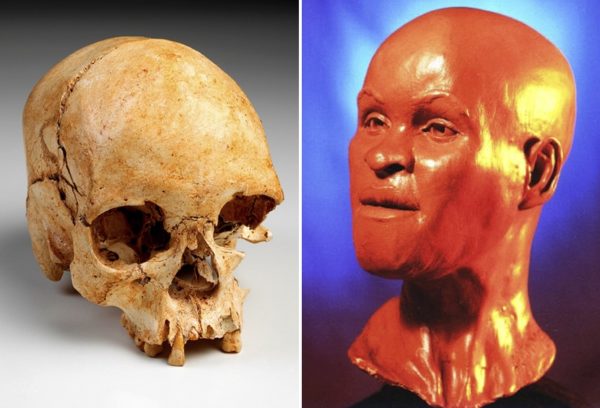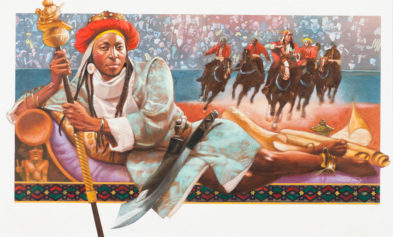RIO DE JANEIRO (AP) — Firefighters found bone fragments from a collection in the still-smoldering National Museum, an official said Tuesday, raising hopes that a famed skull might somehow have survived a massive blaze that turned historic and scientific artifacts to ashes.
Flames tore through the museum Sunday night, and officials have said much of Latin America’s largest collection of treasures might be lost. Aerial photos of main building showed only heaps of rubble and ashes in the parts of the building where the roof collapsed.

This combination of two undated handout photos provided by Brazil’s National Museum shows the skull of Luzia Woman, left, and a reconstruction of Luzia, right, at the National Museum of Brazil in Rio de Janeiro. Discovered during an excavation in 1975 outside of the Brazilian city of Belo Horizonte, Luzia’s fossilized remains sat in storage for two decades. In the mid-1990s, tests by scientists determined it was the oldest fossil in the Americas. It was given the name “Luzia,” homage to “Lucy,” the famous 3.2-million-year-old remains found in Africa. (Museu Nacional Brasil via AP)
The firefighters “found fragments of bones in a room where the museum kept many items, including skulls,” said Cristiana Serejo, the museum’s vice director. “We still have to collect them and take them to the lab to know exactly what they are.”
In its collection of about 20 million items, one of the most prized possessions is a skull called Luzia, which is among the oldest fossils ever found in the Americas.
Museum spokesman Marcio Martins noted that the collection contains hundreds of skulls, and all material would first need to be examined by the Federal Police, who are investigating the still-unknown cause of the fire. Experts will then examine them to determine their identity.
Many have already said that regardless of what is salvaged, the loss will be immeasurable. Marina Silva, a candidate for president in upcoming elections, called it a “lobotomy of Brazilian history.”
The Globo newspaper wrote in an editorial published Tuesday: “The size of the catastrophe is vast: It struck the national memory, through the loss of the important historical collection; it affected the sciences, interrupting research; and it represents a cultural loss impossible to quantify. We only know that it is enormous.”
Investigators were first allowed to enter the main building Monday, but it is still off-limits to researchers. Instead, some scientists were focusing attention on an annex on the site, where vertebrate specimens were housed. The fire didn’t reach the area, but it caused the electricity to fail, threatening some artifacts, said Marcelo Wexler, a researcher in the vertebrate department.
“We have animals that need to be frozen, and they were rotting without electricity,” Wexler said.
In a sign of the enormity of the task ahead, a museum security guard created a stir when he arrived on the scene carrying a document he said belonged to the institution that he had found across the street.
“I came here to give it back. I am sure there is much more that flew around,” Felipe Silva told a group of journalists who crowded in to see the document, which he put in a clear plastic folder.
Even as efforts turned to searching the rubble, firefighters were still occasionally directing water at the building, where some embers were still burning. Eduardo Rosse, a fire official, said that was normal for a blaze of this size.
Luiz Fernando Dias Duarte, a museum official, said Monday that anything held in the main building was probably destroyed, and Serejo told the G1 news portal that 90 percent of the collection may have been destroyed.
But on Tuesday, she held out some hope, telling journalists that staff members were “reasonably optimistic about finding some more items inside.”
She added that UNESCO, the U.N.’s cultural agency, had offered financial and technical assistance. French and Egyptian officials also have offered help. The museum was home to Egyptian artifacts, and Egypt’s ministries of foreign affairs and antiquities have expressed concern over the fate of those objects.
With the cause still under investigation, many already have begun to fix blame, saying years of government neglect left the museum underfunded and unsafe.
Roberto Leher, rector of the Federal University of Rio de Janeiro, to which the museum was linked, said it was well known that the building was vulnerable to fire and in need of extensive repair. In fact, the institution had recently secured approval for nearly $5 million for a planned renovation, including an upgrade of the fire-prevention system, but the money had not yet been disbursed.
On Monday, government officials promised $2.4 million to shore up the building and promised to rebuild the museum.
Here is a look at some of the museum’s most notable pieces, according to its website:
‘LUZIA’
Discovered during an excavation in 1975 outside of the Brazilian city of Belo Horizonte, the fossilized remains sat in storage for two decades. In the mid-1990s, tests by scientists determined it was the oldest fossil in the Americas. It was given the name “Luzia,” homage to “Lucy,” the famous 3.2-million-year-old remains found in Africa.
ANCIENT EGYPT
Among the Egyptian relics is the mummy of Sha-Amun-In-Su, dating back to 750 B.C. The mummy was in its original coffin, which was closed. It was given to Dom Pedro II by Egyptian Viceroy Ismail Pasha during a visit to the Middle East.
INDIGENOUS REMAINS
One of the museum’s most important expositions of indigenous peoples were three bodies mummified together, an adult and two children. It was originally found in the state of Minas Gerais. The collection also includes bows and arrows from different indigenous groups and explanations about studies conducted by the royal family on the Tupi and Guarani languages.
METEORITE
Called Bendego and weighing more than five tons, the meteorite is the largest ever found in Brazil. It was found in the state of Bahia in the 18th century. The meteorite, which sits in a main entrance, could be seen in the burned-out building.
DINOSAUR
One of the museum’s most popular displays was one of its biggest, a dinosaur called Maxakalisaurus tapai. Found in Minas Gerais in 1998, the excavation and reconstruction of the dinosaur took 10 years.
